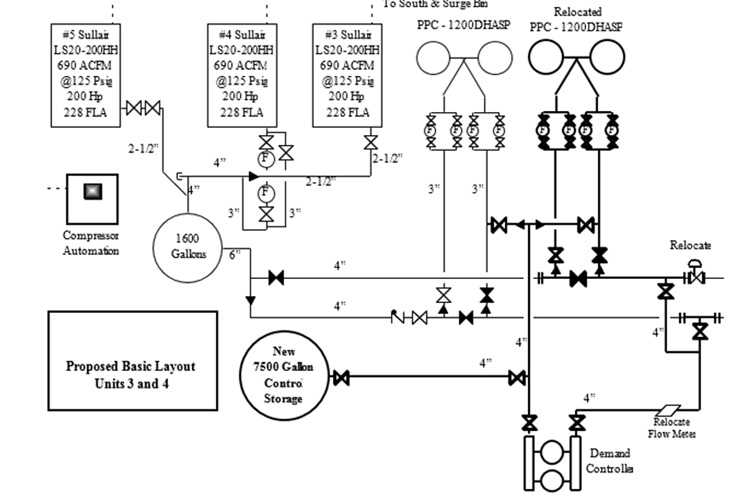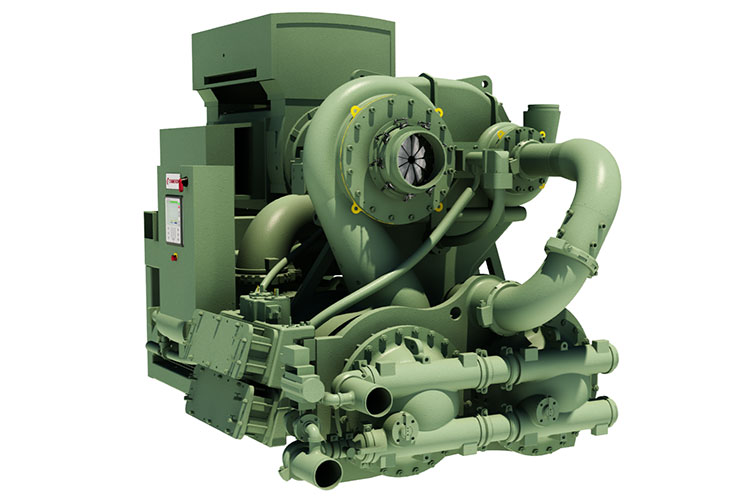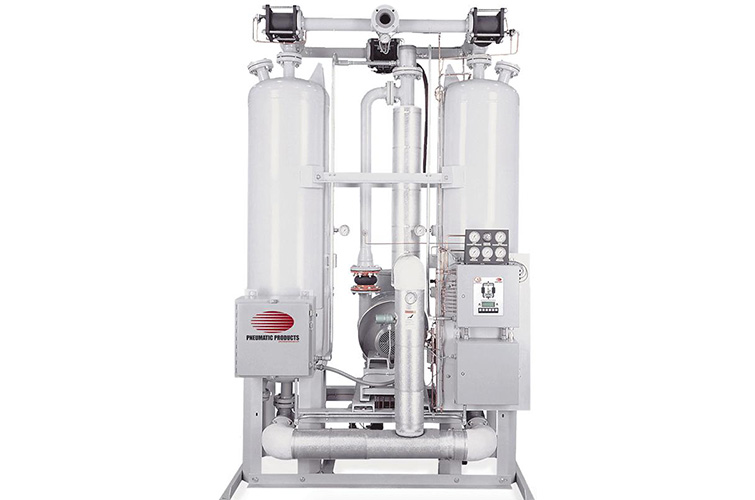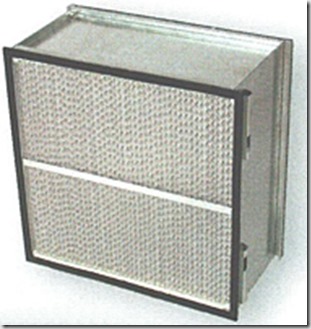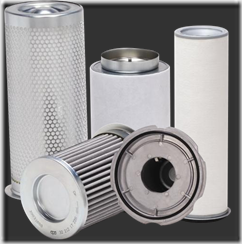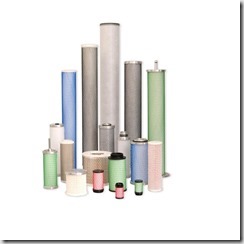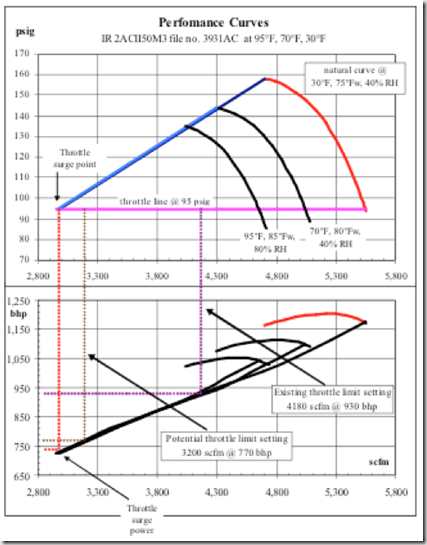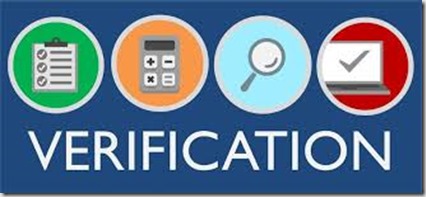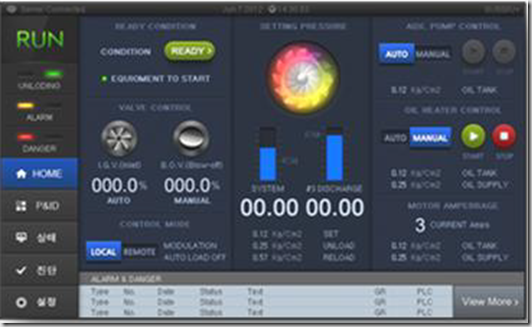Just around the corner is the heat of summer. Get your compressed air system ready now with Fluid Flow’s spring cooler promotion. Details here – Beat the heat!
Compressed Air Filtration
We spend a lot of time discussing compression & drying technology but the filtration in your compressed air system is equally important. Filtration on compressed air systems is vitally important from the compressor intake on the front end to final filtration before use applications.
We’ve previously discussed just how much contaminant is in the ambient air from fine particles to water vapor. At the intake of the compressor, we can’t expect to filter out water vapor but we can certainly remove particulate contamination which could easily damage the internal components on our compressor. The inlet filter to your compressor is critical regardless of the type of compressor. Note that some types are more critical than others. A centrifugal compressor, with it’s tight tolerances would be the most important but even a reciprocating compressor needs to keep contaminant out.
Contaminants can be found from something as simple as pollen from the surrounding area or as complex as particles generated within your manufacturing process or a nearby plant.
A typical inlet filter element for a centrifugal compressor will be 2 micron with an efficiency of 99% or better which eliminates the majority of airborne particulate. In a normal installation this level of filtration will be more than adequate.
I’ll also note here that in rare circumstances there can be chemical vapor intrusion into the compressor. These chemical gas vapors can come from within your manufacturing facility (chemical, Pulp & Paper). It is best practice to place the compressor intake filter away from these potential contaminants as they can lead to premature erosion of key internal components. In the event the intake cannot be relocated there are options for catalyst type intake filters that can remove the chemical vapors. This is a highly expensive route to correcting this issue.
The oil filter on your compressor is another key item. Few items can destroy a compressor quicker than contaminated oil. Always use a high quality OEM oil filter! Even on compressors we service with non-OEM parts we stand certain these components are manufactured to the OEM or higher specifications. With something as inexpensive as an oil filter, never take a chance!
Centrifugal compressors will normally have a vacuum drawn on the oil reservoir to assure any oil vapor is pulled back into the oil system and not be allowed to bypass oil seals and migrate into the air system. The vacuum system regard less of electric or venturi type will have a small filter to prevent oil vapor from entering the atmospheric air near the compressor. Make sure these are kept clean and in good working order.
Depending on the type of air dryer used in conjunction with the compressor there may be pre-filter elements prior to the air entering the dryer. This is especially important when using desiccant type dryers. For desiccant dryers this pre-filter element will be a coalescing type element to remove any liquid water prior to the air reaching the desiccant bed in addition to any oil carryover. A normal rating for this type of pre-filter would be at minimum an oil pass rate of 0.0014 ppm by weight when subject to an inlet condition of 50 ppm by weight. In refrigerated dryer applications this could be a particulate only type element to prevent any contaminants generated within the compressor from passing further downstream. *A coalescing type element will actually coalesce both water/oil from the airstream in addition to capturing particulates.
With the use of a refrigerated dryer, this will likely be the last filter element in the system prior to use. The exception here would be a point of use filter typically combined with a regulator and potentially an lubricator. These units are often called FRLs. First since we deal in oil free compressed air there is not normally a lubricator although if all of the air is generated from an oil free compressor and used everywhere in the plant there could be applications that require lubrication.
Unless there is a concern of contamination entering the compressed air system from within the plant air piping, I never recommend the installation of filters at the point of use. Typical FRLs filters are not very efficient and typically do cause a high pressure drop.
If the plant uses a desiccant dryer then there will normally be one additional filter downstream of the desiccant dryer. This will be a particulate element to capture any desiccant fines or dust that are pulled downstream. This can occur when the desiccant begins to fail, losing crush strength or from attrition. A typical rating for this type of after-filter would be 0.9 micron at 99.99% efficiency.
There are other types of filters that will be found in lubricated compressor applications and of course specialty applications, such as breathing air, can have a myriad of additional filtration installed but what has been discussed would be a normal compressed air system.
If in doubt the best solution is to contact your local compressed air specialist and schedule an on site review for your specific plant requirements.
As always, if I can be of any assistance please feel free to contact me to discuss.
Compressed Air Audit–The Trials of a Client
Almost everyone who works in a plant around compressed air has heard the term “Air Audit”. And if you’re in a position to talk to sales people I’m sure nearly every one has discussed an air audit for your plant. Supposed air audit professionals are everywhere and prices for such a service range from FREE to thousands of dollars. So how is an end user to decide which company to select to evaluate their compressed air system?
I was recently in a meeting with a paper mill to discuss new local controls for their centrifugal compressors. This particular plant knew that the local controls were antiquated and if any of the components failed there was nowhere to purchase spare parts. Also, the plant had recently paid to have an air audit performed at their facility to determine applicable steps that could be taken to increase the efficiency of the compressed air system.
After going through our sales presentation on our proposed local controls, the plant personnel brought up the topic of a new compressor. We of course stated we would be glad to discuss a new compressor and at the time even had a great deal on an inventory unit.
However, we also brought up that according to other plant personnel, the audit didn’t call for a new compressor so we were slightly confused.
They stated they were not 100% on board with the audit findings and still felt one additional compressor at the same size range as their current units would put them in a better position.
As we progressed through our conversation, we asked if they had pressure reducing valves in the plant for any of their steam systems. We were told they did and we subsequently discussed steam pressures from the boilers, the steam usage pressures and amount of available steam.
From our preliminary conversations it appeared they had enough steam to drive a decent size centrifugal compressor so we tossed the idea out of running the new compressor via a steam turbine drive which basically provides them with free compressed air. We simply use a steam turbine as a PRV in the plant.
They thought this was a fabulous idea and were thrilled we brought up the idea. Again, somewhat confused, we asked if the audit they had just paid for discussed steam turbine driven compressors and they replied “No” , they had never heard of this.
Obviously, I’m not going to state who the original audit company was but at the end of the meeting the plant personnel told us they would like to hire our auditing division to come on site to do another air audit. By this point they had zero confidence in the audit for which they had just written a check.
It pains me to think that any company (or individual) has just paid for something from which they receive no benefit.
Now back to the original question, how does a company determine who to hire for an air audit. I can’t honestly give you a complete answer but I have a few suggestions.
Like so many things – you get what you pay for. If you take a company up on a free air audit you should expect primarily a sales pitch for a report
Review sample reports – even the best audit is worthless if you can’t understand the report and/or it doesn’t give you valuable information.
The report should have clear, concise progressive steps to be taken to achieve the most reliable, efficient compressed air system. Make sure these are shown in order of importance and you are given pricing for each section or stage and not just a total implementation estimate. Many times the cost to achieve compressed air nirvana can be hundreds of thousands and into millions of dollars. Most plant budgets just can’t take that kind of hit all at once so you’ll want to implement in stages.
Check References – especially references from like companies. If you’re a chemical company then you need references from chemical companies. Same for power generation, pulp & paper, automotive assembly, tire plant or whatever your industry happens to be.
It’s obviously important to have an audit group that knows compressed air but in my opinion, it’s equally beneficial if that group has performed multiple audits in the same type of plant as yours. Experience within that area can provide valuable information you might not otherwise receive.
In the case of the paper mill earlier, I’m hopeful the original audit company did their best for the client but simply did not know the right questions to ask. We have done audits in so many paper mills that we know an abundance of steam along with PRV’s is a norm at these facilities so we knew the right questions to ask.
I hope these quick suggestions are helpful as you look to improve the compressed air efficiency in your facility.
If you have any question feel free to contact me to further discuss.
Controlling Surge & Manual Tuning
I was recently on a service job and watched the tech surge test the compressor. I’ve seen it done a number of times but for some reason a question came into my mind.
I know the tech is manually manipulating the inlet & bypass valves to increase the unit pressure thus forcing the compressor into a surge condition. He is listening for the whooshing sound a compressor makes when the max pressure is reached and the air slips into a reverse flow.
The question that hit was how exactly does the controller know when a surge condition has been experienced. A quick call to my service manager got me the explanation I wanted and I thought you too might benefit from knowing the answer.
The controller is always looking at the unit pressure. Not just the final discharge pressure but also the pressure at each stage of compression. The controller registers a surge when it see a simultaneous drop in pressure and a drop in motor amps. The controller can register the surge regardless of which stage the pressure drop occurred. Meaning the surge could have occurred in any stage of the compressor, not just the final stage.
Once the controller reaches the pre-set surge count, which is usually programmed by the technician setting up the unit, it pushes the surge line out so the compressor should not reach this point again. By limiting how far the compressor can go the controller keeps surge from occurring again.
Now that the controller has automatically compensated for the compressor surging we need to further consider: Why did the compressor have a high number of surges?
This could be caused by a number of reasons including compressor component wear. Perhaps the impeller or diffuser has been worn by particulate or water erosion which now limits the ability of the compressor due to a change in tolerances. More likely, the cause can be attributed to a change in ambient conditions. Very likely a temperature change in the air inlet temperature or a change in humidity has occurred or a combination of both.
Further consider that while the controller has modified settings to protect the unit from further surges it has also taken away a potentially useful area of operation. You see the controller can push the surge line out to prevent further operation within the effected surge area but it will not reverse the line in the opposite direction. So when ambient conditions again allow compressor operation within the previous zone the controller will not allow operation back within this area without being forced.
To force the controller to allow operation within this zone again a manual tuning must be done to override the controllers automatic pushing of the surge control line. Think of this as a reset of the controller’s parameters so to speak.
To accomplish this the unit is manually tuned to the proper control set points by a certified technician or knowledgeable operator.
For this reason we recommend manual control tuning be performed at the beginning of each seasonal weather changes. So as the temperatures begin to rise in the late spring or the temperatures begin to drop in late fall the compressor should be manually tuned by your authorized service company.
When we are selected to provide a preventative maintenance or closed cost service contract we actually retune the compressor each quarter. If your company is without a contract we recommend at least retuning the compressor twice per year.
As always, if you have any questions, feel free to contact me to discuss further.
Compressor Performance Comparison
Last week we discussed how air compressors are rated in performance using variations of CFM (Cubic Feet per Minute).
The article discussed keeping the performance stats consistent for comparison. However, even if various air compressors are listed in the same specification units – how do you know for certain the unit performance you’re being given is an accurate number?
For those of you unfamiliar – enter CAGI. CAGI stands for compressed air & gas institute. Reputable manufacturers that offer products within CAGI’s area are members of CAGI. A great service that CAGI started many years ago is having compressor manufacturers submit compressor performance data to CAGI which is then verified.
With this tool available you can be assured the data you receive is accurate.
You can find the starting point for verification at the following link:
If you have any question feel free to contact CAGI or myself to discuss.
Understand The Basics: CFM
Anyone that’s been near an air compressor is familiar with the term CFM. It’s quite simple and is an acronym for “cubic feet per minute”. This is a flow measurement based on volume, not weight.
Any cubic foot of air occupies the same space but will have different weights depending on:
Temperature
Humidity
Absolute Pressure
Why is this important?
It’s important to understand to properly match your plant load requirements to your air compressor purchase. Different manufacturers display their compressor flow data with various terminology.
ICFM – Inlet Cubic Feet per Minute
ICFM is a measurement of the air flow prior to any component of the compression equipment such as an inlet filter (which will cause a drop in pressure)
SCFM – Standard Cubic Feet per Minute
SCFM is a measurement of air flow at an industry standard condition. That specific condition is normally stated in the U.S. as 14.696 PSIA (pounds per square inch – absolute), 60 degree F (520 degree R) and 0% relative humidity (RH).
ACFM – Actual Cubic Feet per Minute
ACFM is the actual cubic feet of air that is being delivered from the compression equipment. If the exact conditions at the compressor location are equal to the SCFM standard conditions then the ACFM would equal the SCFM. However, this almost never happens!
FAD – Free Air Delivered
FAD is the actual quantity of compressed air converted back to the inlet conditions of the compressor.
The 2 most typical stated flow rates normally seen are ICFM and SCFM. As long as all the performance data is kept in one type of calculation then comparison of various compressors should work.
However, to assure you are getting a compressor that will actually meet the plant requirements I always ask the client to specify the worst possible operating conditions so compressor performance can be calculated at that point.
If you select a compressor based on SCFM alone then you will not get the stated flow when the summer conditions are 98 degree F ambient and the cooling water is 110 degree F and humidity is 52%.
The flow rates of air compressors is a widely changing variable and many white papers have been written on the subject so end users truly understand what performance they will receive from a specific unit.
We are available to present an entire session on this topic if you would like to completely understand air compressor flow rates. As a bonus for our readers that are in the engineering discipline, PDH credits can be received for this seminar.
Centrifugal Compressor Controls Tuning
A simple concept of air density is cool air is more dense than warm air. In a centrifugal compressor application where the flows and pressure are created dynamically the inlet conditions play a major role in the performance of the compressor.
Several factors play a contributing role in the performance including inlet pressure which should remain constant at your physical location. However, the variable factors include inlet air temperature, humidity and cooling water temperature.
Lower intake air temperatures as well as cooling water temperatures usually go hand in hand. The lower temperature air will be more dense and will result in higher free air delivery (ACFM) and also higher power consumption of the compressor.
Another factor in air density changes is the available turndown of the compressor. Meaning the effective flow range through the use of a throttle valve or inlet guide vanes is possible. A lower temperature inlet air will allow for a wider range of operation in the compressor thus offering a larger amount of turndown.
The lower inlet temperature air also increase the surge pressure!
During the heat of summer the alternate is true where less volume is produced by the compressor and subsequently, less horsepower is used but there may exist an circumstance that the unit will not be able to produce the required plant volume if the unit was not sized appropriately at the onset.
All of this information is critical in initially sizing a dynamic compressors but the point we’re looking to make is the ambient conditions do change the performance of the machine.
Modern controls are designed to keep the compressor out of surge or choke conditions by moving the surge line to an acceptable position. However, by moving the surge line the performance of the unit is also altered.
This is the primary reason we suggest re-tuning each centrifugal compressor based on the season. At least twice per year (as the ambient temperatures increase for summer and decrease for winter) is an ideal time to tune the compressor to achieve peak performance and maximize energy savings.
If your plant has a maintenance contract with a service provider, make sure that tuning the compressor is included twice per year as recommended. If you perform you own service I would advise contacting a local service company to perform these tuning parameters for your as a one off service. Typically, tuning controls is outside the expertise of plant maintenance personnel.
What’s Wrong With My Centrifugal Compressor
Like any piece of mechanical equipment, your centrifugal compressor can experience problems.
On any given day things are running great and suddenly there is an increase in vibration, The discharge pressure falls or the outlet temperature is too hot.
The question is: What’s wrong.
The simplest solution is to contact your local service professional but sometimes you just want to check it out yourself. Whether for personal satisfaction or you really need your compressor running in the next few minutes there are always a few simple items you can check and perhaps correct on your own.
We’ve put together a simple list of troubleshooting tips based on potential problems. Feel free to download the guide which may save you some time in your search.
Inspections & Checklists–Centrifugal Compressor
After learning about all the components in your centrifugal compressor you should now have a comfort level knowing about the parts and operation of your machine.
To keep your compressor running like new takes time for regular inspections and will also save money on operational cost. Many of the suggested inspections can be performed by your plant maintenance personnel and keeping detailed records will also help to understand problems as they arise. At the very least it will be helpful and therefore less costly when your compressed air professional needs to assist with any problems.
Below is a list of typical items you should be reviewing and the suggested frequency that items should be checked.
Scheduled Maintenance Procedures
Daily:
- Operating data logged during loaded operation and reviewed
Monthly:
- Inlet air filter elements inspected, (replaced if required)
- Oil reservoir venting system filter elements inspected, (replaced if required)
- Compressor bypass valve air supply filter checked (if applicable)
- Intercooler / aftercooler condensate removal system checked
- Control system operation checked
Quarterly:
- Compressor operations data analyzed
- Main drive motor bearings lubricated per motor manufacturers instructions
- Condensate traps cleaned and inspected
- Intercooler, aftercooler, and oil cooler performance verified
- Lubrication system oil analyzed
6 Month Interval
- Oil reservoir venting system (air ejector) filter element changed
- Oil system filter element changed (if required)
- Lubrication system oil tested and changed, (if required)
- Oil pump motor lubricated with recommended grease (if required)
- Coolant and condensate chemically tested
- Compressor inlet and discharge valves inspected
- Inlet guide vane assembly drive screw lubricated (if applicable)
- Bypass valve lubricated (if Required * Note manual recommendations)
- Bypass valve air supply filter replaced (If applicable)
- Bypass valve silencer element and gasket replaced
- Discharge air check valve inspected and tested for free operation
- Main drive coupling inspected (coupling type dependent – see manual for proper maintenance)
- Main drive motor maintenance checks completed and correct alignment verified
- Perform compressor surge test, recorded result and adjust control setpoints
To further assist you with the checks and inspections above you can download this list at the following link: Maintenance Checklist
To assist with your information collection you can find a checklist to download at the following link:
Of course there will always be items that are beyond the scope of your plant personnel. That’s when its time to call in a professional. We recommend an annual visit by your selected service company for detailed inspections on your equipment and to handle the more difficult maintenance that typically requires the unit to be dis-assembled to some degree.
Of course that doesn’t mean you should be out in the dark. You can download a checklist at the link below that helps you know in advance what items (minimum) that your professional technician should be covering and assist you in making sure all items are covered.
I hope the above lists and inspections items are helpful as you work to keep your compressed air system in top operating condition.
Controls
We’ve progressed through the components of a centrifugal compressor. While the goal is to supply the plant with oil free compressed air, the ideal conditions of supply and demand rarely, if ever, match up. Meaning the plant use is never matched with the exact output of the compressor.
For that reason a controller is implemented to match the output of the compressor with the needs of the plant. The controller is responsible for monitoring all of the instrumentation on the compressor such as vibration probes, oil pressure, oil temperature, air temperature both entering the compressor as well as the temperature at the different stages. This is to assure proper cooling is taking place in the intercoolers. The controller also typically monitors the pressures at the discharge of each stage to assure the unit is operating at the design point and also measures the motor current.
Turndown
Another important term to understand in the centrifugal compressor world is turndown. Basically, turndown is the operating range of the compressor between the lines of surge and choke.
This gives the end user an understanding of the operating range of the compressor which assists in understanding the efficiency of the unit. Since the requirements of the plant rarely match the exact output of the compressor we need to know how much the compressors can effectively throttle back to match the plant air requirements.
Control Mode
The controller may normally be set up to control in several different scenario’s.
Constant Pressure:
Constant pressure control is frequently used when system air pressure must be held steady at a specific value or in processes where swings in system pressure is not acceptable. The inlet valve is modulated to meet the system pressure set point while holding motor current within the Max/Min set points. In a case of low demand, the compressor will throttle back to the surge control set point. If demand continues to fall below these set points, the discharge (blowoff) valve will open (modulating if capable) to bypass enough flow to keep the compressor from reaching a surge condition.
Constant Flow
Constant flow control provides a constant flow delivered from the compressor to the system in special applications and works much the way constant pressure controls work.
Auto Dual
Auto Dual control provides efficient compressor operations where some pressure swings are acceptable to the plant. In Auto Dual mode the compressor controls operate the same as constant pressure until the compressor throttles back to surge control set point. If demand falls below the throttled condition the controller will unload the compressor. If the plant requirements increase the compressor will reload to supply air to the plant. On some models, if the demand remains below this threshold for a set period of time the compressor can be programmed to shutdown and auto restart when system demand requirements rise.
Efficiency Note
The controller for the compressor has a primary function of assuring the compressor meets the demand of the plant air system requirements. Secondarily, the controller should operate the compressor at peak efficiency in order to keep electrical operating cost to a minimum. Any time the discharge (blowoff) valve is open, expensive compressed air is being blown off to the atmosphere. After paying to compressor the air, blowing it to atmosphere is a tremendous waste of resources.
While most manufacturers offer a variety of interconnected local controllers, Most of these controllers simply do not have the computational power to fully utilize the compressor at peak efficiency. Regardless of control methods, sophisticated algorithms in central control systems offer faster monitoring & control while utilizing more sophisticated programs. An example would be where the master controller monitors the rate the system pressure falls to determine the likely time expectancy that the unit will need to reload.
For maximum efficiency it is always recommended to hire a professional compressed air auditing group that maintain engineering personnel dedicated to control systems.

